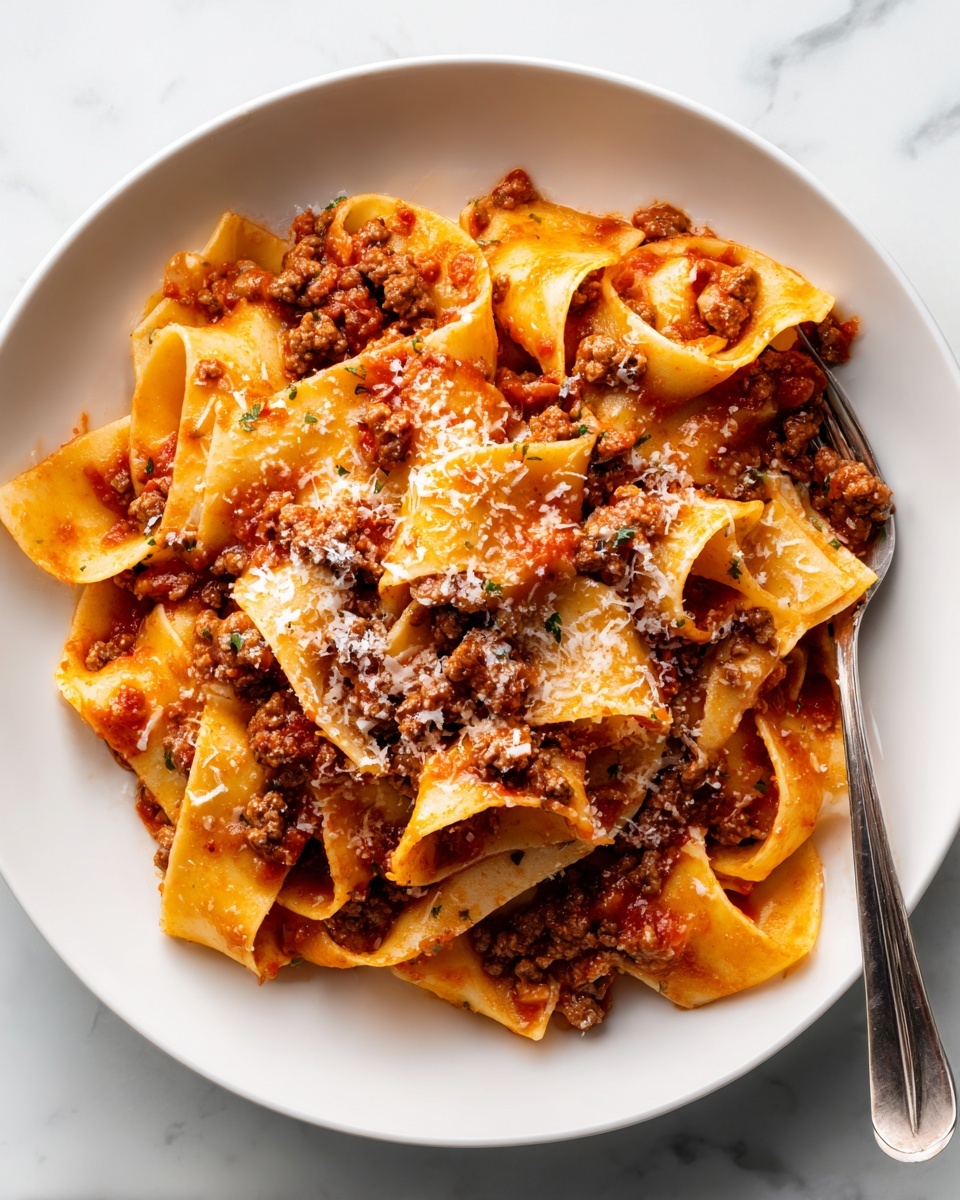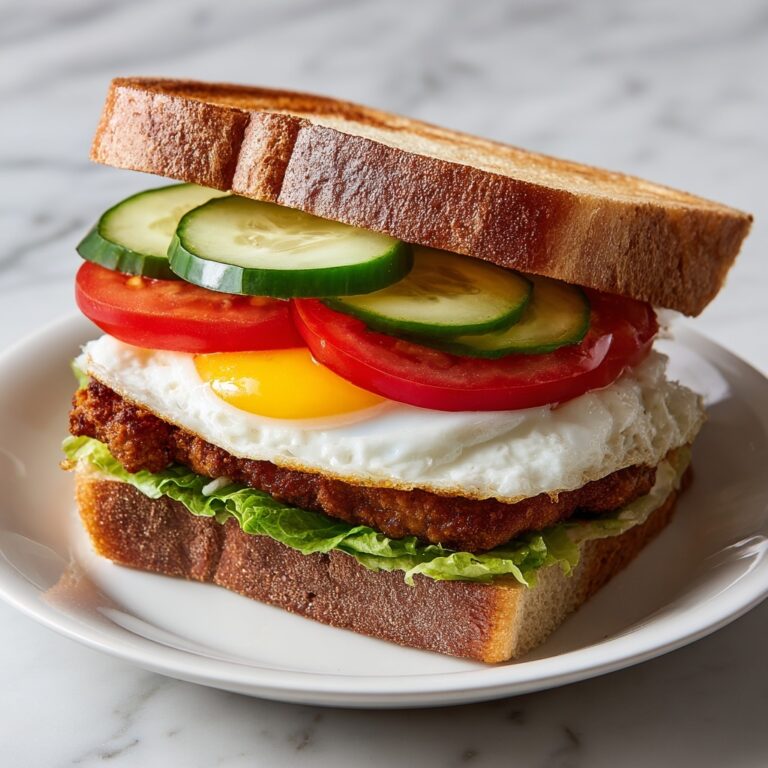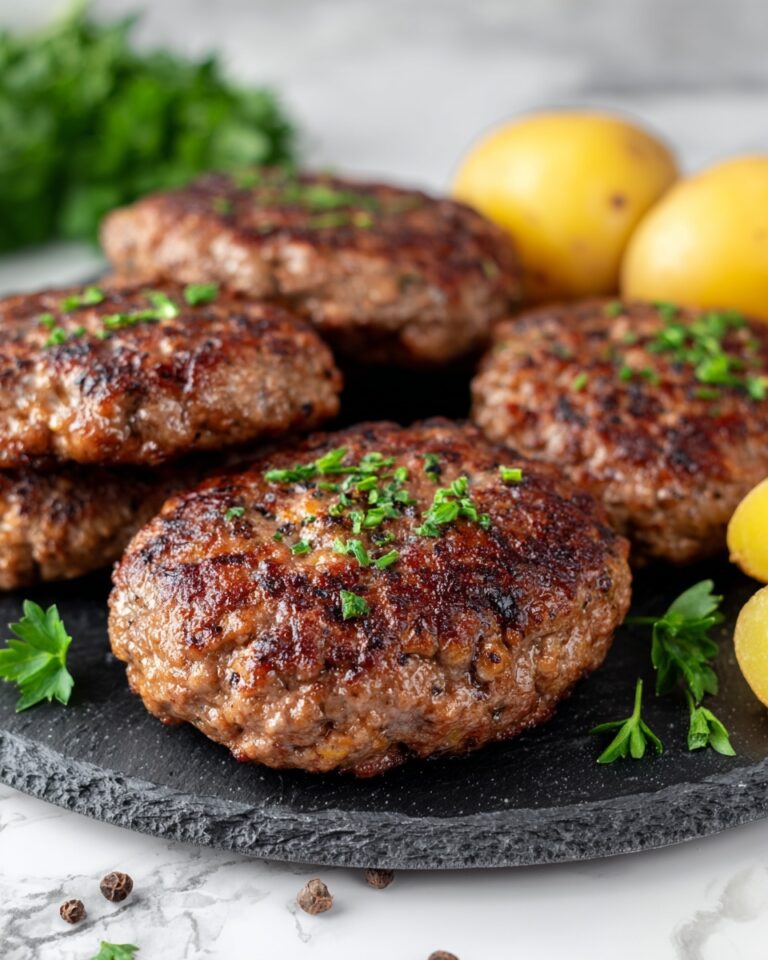If you have been searching for a soul-warming, deeply flavorful dish that feels like a big, comforting hug from the Italian countryside, this Tuscan Ragu Recipe is exactly what you need. Rich and hearty, it blends the rustic aromas of garlic, rosemary, and red wine with succulent beef and pork, slow-cooked to perfection. This traditional ragu offers a perfect balance of robust tomato flavors and delicate vegetable sweetness that lingers delightfully on the palate. Whether you’re serving it on a chilly evening or impressing guests with its authentic taste, this recipe will become a beloved staple in your kitchen.
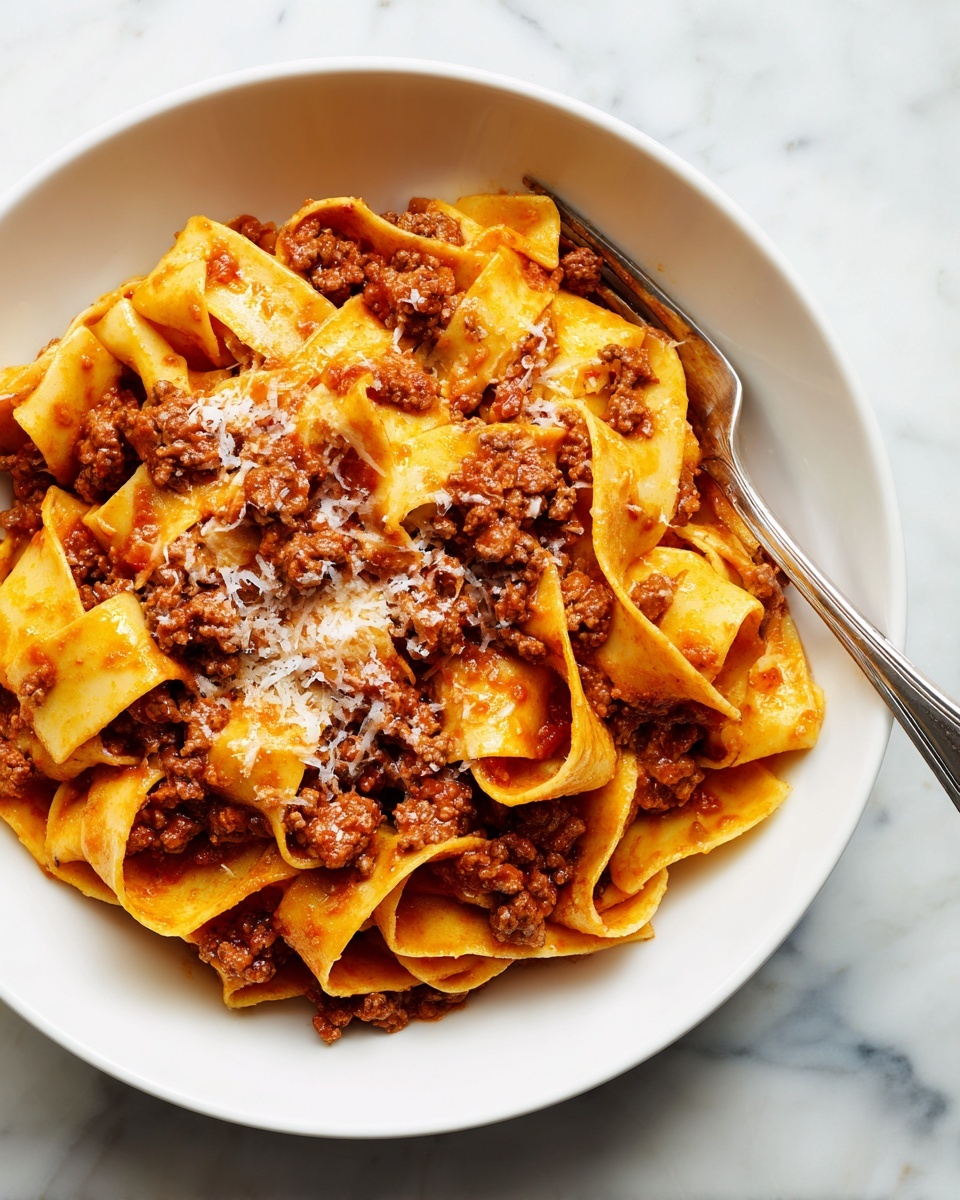
Ingredients You’ll Need
Gathering the ingredients for this Tuscan Ragu Recipe is simpler than you might think, and each one plays a crucial role in building the depth and richness of the final dish. From aromatic vegetables to hearty meats and silky tomato elements, these humble yet essential components come together to create a ragu that sings with flavor.
- Olive oil: A tablespoon or two for sautéing vegetables, offering a fruity richness and smooth texture.
- Onion, chopped: Provides a subtle sweetness that forms the flavor foundation.
- Celery, diced: Adds crisp freshness and a slightly peppery undertone.
- Carrots, chopped: Bring natural sweetness and vibrant color to the mix.
- Garlic cloves: Infuses the ragu with pungent, savory warmth.
- Rosemary leaves: Just the leaves, chopped finely for an aromatic herbal note that evokes Tuscany’s hillsides.
- Beef mince (900g / 2lbs): The core protein offering juicy, meaty richness.
- Pork sausage (450g / 1lb), casing removed: Adds extra flavor complexity and fat for a silky sauce.
- Dry red wine (250ml / 1 cup): Essential for deglazing and lending deep, fruity acidity.
- Canned chopped tomatoes (400g / 14oz): Provide a hearty tomato base with texture.
- Tomato passata or crushed tomatoes (500ml / 17½ oz): Gives the sauce body and a smooth, rich mouthfeel.
- Tomato paste (3 tbsp): Intensifies tomato flavor and helps thicken the sauce.
- Salt: Enhances all the combined flavors perfectly.
- Black pepper (½ tsp): Adds a hint of gentle heat to round out the palate.
How to Make Tuscan Ragu Recipe
Step 1: Sauté the Vegetables
Begin by warming 1 tablespoon of olive oil in a large, deep pan or Dutch oven over low heat. Add the chopped onion, diced celery, chopped carrots, minced garlic, and finely chopped rosemary leaves. Cook gently for about 10 minutes, allowing the vegetables to soften without browning. This slow cooking mellows the aromatics and forms the delicious natural base of your ragu.
Step 2: Brown the Meat
Next, add the beef mince and removed pork sausage to the softened vegetables. Use a spatula to break the meat apart as it cooks over medium heat. Stir this mixture constantly, browning until the meat loses all pinkness and develops a lovely, rich color. This step builds essential flavor through caramelization.
Step 3: Add Wine and Tomatoes
Pour in the dry red wine, letting it bubble away for about 10 minutes on medium heat to evaporate the alcohol and concentrate its fruity essence. Then stir in both the canned chopped tomatoes and the passata or crushed tomatoes, followed by the tomato paste. Season with salt and pepper, mixing well before reducing heat to low. Cover the pot and let the ragu simmer gently for 1.5 hours, stirring occasionally to prevent sticking and allow flavors to meld deeply.
Step 4: Adjust Seasoning
After the long, slow simmer, taste your Tuscan Ragu Recipe and adjust salt as needed. If the sauce feels too thick, add a splash of water to loosen it to your desired consistency. Continue cooking uncovered as necessary until the sauce is thick, meaty, and irresistibly rich.
How to Serve Tuscan Ragu Recipe
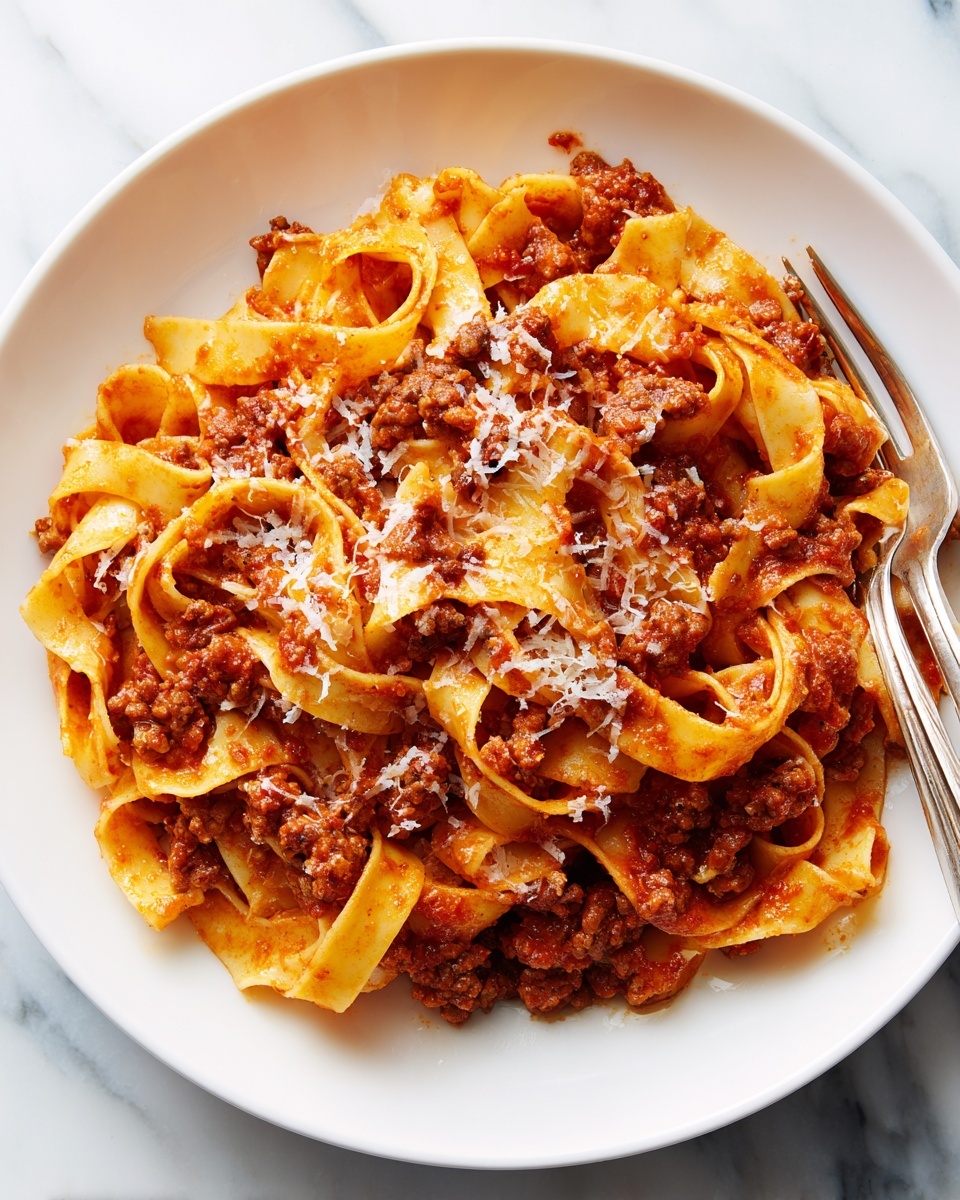
Garnishes
To elevate your ragu, consider garnishing with a handful of freshly grated Parmesan cheese or shards of Pecorino Romano. A scattering of chopped fresh basil or a light drizzle of good-quality extra virgin olive oil also adds fragrant, fresh notes. These finishing touches highlight the rustic character of the dish beautifully.
Side Dishes
This ragu shines served over freshly cooked pasta like pappardelle or tagliatelle, which catch the chunky sauce perfectly. Creamy polenta or buttery mashed potatoes are comforting alternatives that soak up every delicious bite. For a lighter option, steamed greens or a simple arugula salad with lemon vinaigrette create a lovely, bright contrast.
Creative Ways to Present
Beyond traditional pasta, try layering the Tuscan Ragu Recipe in a baked pasta casserole topped with mozzarella for a crowd-pleasing dinner. Spoon it over roasted vegetables or use it as a hearty filling for stuffed bell peppers. The versatility of this ragu means you can get creative and tailor it to any occasion!
Make Ahead and Storage
Storing Leftovers
Once cooled, transfer the leftover ragu to an airtight container and store it in the refrigerator. It will keep beautifully for up to 4 days, with the flavors only growing richer as it rests. Leftovers are fantastic for a quick meal when time is short.
Freezing
This Tuscan Ragu Recipe freezes wonderfully. Portion into freezer-safe containers or bags, ensuring to remove as much air as possible before sealing. Frozen ragu can be kept for up to 3 months without losing its incredible flavor or texture.
Reheating
Reheat the ragu gently on the stove over low heat, stirring occasionally to prevent sticking. If the sauce has thickened too much in the fridge or freezer, add a splash of hot water, broth, or wine to restore its luscious consistency. Microwave reheating works fine, but stirring halfway through helps it heat evenly.
FAQs
Can I use different meats for this Tuscan Ragu Recipe?
Absolutely! While the classic version uses beef mince and pork sausage for rich flavor and texture, you can experiment with veal, lamb, or even game meats for a unique twist. Just keep the ratio of fat to lean meat balanced for the best sauce consistency.
Is it possible to make this ragu vegetarian?
Yes, with some modifications. Replace the meat with a combination of mushrooms, lentils, and plant-based mince alternatives, and use vegetable broth instead of wine if desired. Your aim is to maintain the deep, savory flavor, so sautéing the vegetables slowly is crucial.
What pasta pairs best with Tuscan Ragu Recipe?
Wide, flat pastas like pappardelle or fettuccine are ideal because they hold the chunky sauce well. Penne or rigatoni also work nicely if you want shapes that trap every meaty bite.
Can I prepare the base vegetables ahead of time?
Definitely! You can chop and even sauté the onion, celery, carrots, garlic, and rosemary up to a day in advance. Just store them in the fridge in an airtight container until you are ready to continue the recipe.
What if I don’t have tomato passata?
No worries at all! You can substitute tomato passata with crushed canned tomatoes or blend regular canned tomatoes until smooth. The key is to have a thick, pure tomato base that complements the diced tomatoes already in the dish.
Final Thoughts
There is something truly special about making and sharing the Tuscan Ragu Recipe. It’s a celebration of simple ingredients elevated by time, patience, and love. Whether it becomes a weeknight staple or your go-to for leisurely weekend dinners, this ragu invites you to experience a slice of Tuscany right at home. I can’t wait for you to try it and make it your own.
Print
Tuscan Ragu Recipe
- Prep Time: 20 minutes
- Cook Time: 2 hours
- Total Time: 2 hours 20 minutes
- Yield: 10 servings
- Category: Sauce
- Method: Stovetop
- Cuisine: Italian
Description
This rich and hearty Tuscan Ragu recipe features a slow-simmered blend of ground beef, pork sausage, aromatic vegetables, and robust red wine, resulting in a deeply flavorful meat sauce perfect for pairing with pasta or polenta. The long, gentle cooking method allows the flavors to meld beautifully, creating a classic Italian comfort dish.
Ingredients
Vegetables and Aromatics
- 1–2 tbsp olive oil
- 1 onion, chopped
- 2 ribs celery, diced
- 2 carrots, chopped
- 2–3 cloves garlic, minced
- 1 sprig rosemary leaves, chopped
Meat
- 900g (2 lbs) beef mince (ground beef)
- 450g (1 lb) good quality pork sausage, casing removed
Tomato and Liquids
- 250ml (1 cup) dry red wine
- 400g (14 oz) canned chopped tomatoes
- 500ml (17½ oz) tomato passata or crushed tomatoes
- 3 tbsp tomato paste
Seasoning
- Salt, to taste
- ½ tsp black pepper
Instructions
- Sauté Vegetables: In a large deep frying pan or Dutch oven, heat 1 tablespoon of olive oil over low heat. Add the chopped onions, diced carrots, celery, minced garlic, and chopped rosemary leaves. Cook gently for about 10 minutes, stirring occasionally, until the vegetables soften without browning to develop a sweet base.
- Brown Meat: Add the ground beef and removed pork sausage to the pan. Break the meat up with a spatula and cook over medium heat until browned and no longer pink inside, stirring constantly to ensure even cooking.
- Add Wine and Tomatoes: Pour in the dry red wine and continue cooking over medium heat for about 10 minutes, allowing the alcohol to cook off and the flavors to concentrate. Then add the canned chopped tomatoes, tomato passata (or crushed tomatoes), and tomato paste. Stir to combine, then season the ragu with salt and black pepper.
- Simmer the Ragu: Reduce the heat to low and cover the pan with a lid. Allow the sauce to simmer gently for 1.5 hours, stirring occasionally to prevent sticking and encourage even cooking. The slow simmer will develop deep, complex flavors and tenderize the meat.
- Adjust Seasoning: Taste the ragu and adjust seasoning by adding more salt if needed. If the sauce is too thick, add a splash of water to reach your desired consistency. Continue cooking uncovered if needed until the ragu is thick and meaty, perfect for serving.
Notes
- Use a heavy-based pan or Dutch oven to ensure even heat distribution during the long simmer.
- Remove sausage casings before adding to get a better texture in the ragu.
- Dry red wine is essential for depth of flavor; cook well to remove alcohol taste.
- Simmering gently on low heat ensures tender meat and well-blended flavors.
- Serve traditionally with pappardelle, tagliatelle, or polenta for an authentic Tuscan experience.

